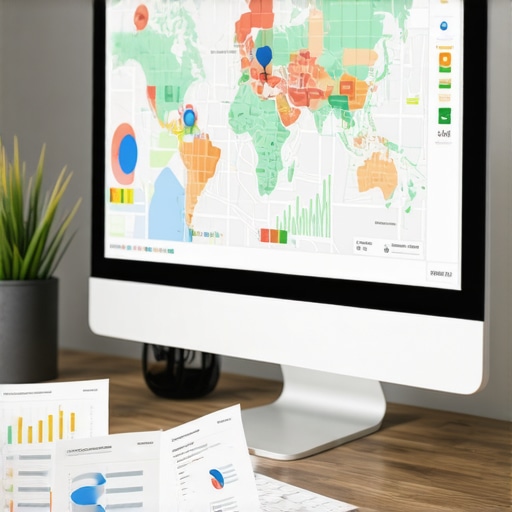Unlocking the Power of GeoGrid Tracking for Local Maps Optimization
In the competitive realm of local SEO, effective maps rank optimization stands as a critical pillar for businesses aiming to dominate their geographic niche. Leveraging advanced GeoGrid tracking strategies not only enhances visibility but also provides granular insights into ranking fluctuations across targeted locations. This article explores the nuanced methodologies that seasoned SEO professionals employ to refine their local search presence through sophisticated GeoGrid mapping techniques.
How Does GeoGrid Tracking Elevate Local SEO Performance?
GeoGrid tracking involves partitioning a target area into a grid of precise geographic points, enabling meticulous monitoring of search engine rankings at each coordinate. This granular data collection facilitates the identification of ranking patterns, local competition dynamics, and temporal shifts influenced by algorithm updates or seasonal trends. Implementing such a system requires an understanding of spatial analytics, as well as integration with cutting-edge GMB software innovations that automate data aggregation and visualization.
What Are the Key Challenges in Implementing GeoGrid Strategies?
How can professionals mitigate the risk of inaccurate data interpretation in complex geographic landscapes?
One of the primary hurdles is ensuring data accuracy amidst multi-layered local variables such as demographic shifts, transient populations, and Google My Business (GMB) profile fluctuations. To address this, experts often utilize comprehensive tracking tools that incorporate real-time updates and validation algorithms, minimizing false positives and enabling precise strategy adjustments.
How Can GeoGrid Tracking Be Integrated with Broader Local SEO Campaigns?
Integrating GeoGrid data with other local SEO tactics, such as review management, citation building, and content localization, creates a synergistic effect that amplifies overall rankings. For instance, analyzing ranking shifts across specific grid points can reveal underserved areas, guiding targeted outreach efforts. Additionally, coupling this approach with advanced GMB software further enhances visibility through optimized listing management and local signal strengthening.
What Future Trends Will Shape GeoGrid Tracking and Maps Optimization?
Emerging technologies such as AI-driven spatial analytics and machine learning algorithms promise to refine GeoGrid accuracy and predictive capabilities. As local SEO evolves, staying ahead entails adopting next-generation tracking tools that harness big data for proactive ranking adjustments. Furthermore, the integration of voice search and augmented reality will necessitate more dynamic and adaptable GeoGrid strategies, emphasizing real-time responsiveness and user engagement metrics.
For professionals seeking to elevate their local maps rankings, continuous innovation and data-driven decision-making are paramount. Explore further insights and share your expertise by visiting our contact page.
Innovative Techniques to Elevate Your GeoGrid Strategy for Superior Local SEO Outcomes
As local SEO professionals strive for increased visibility, understanding the nuanced application of GeoGrid tracking becomes crucial. Moving beyond basic grid segmentation, advanced techniques such as multi-layered grid overlays and temporal analysis enable marketers to dissect ranking fluctuations with unprecedented precision. By integrating these sophisticated methods, businesses can uncover hidden opportunities in underserved areas, optimize their local signals, and ultimately, dominate Google Maps rankings.
How Can AI and Machine Learning Enhance GeoGrid Tracking?
Artificial intelligence and machine learning are transforming traditional GeoGrid approaches into predictive, proactive systems. These technologies analyze vast datasets, identifying emerging trends and potential ranking shifts before they occur. For instance, AI-driven models can simulate future map rankings based on historical data, seasonal patterns, and algorithm updates, providing a competitive edge. Leveraging these tools through platforms like advanced GMB software ensures your strategies stay ahead of the curve.
What Are the Practical Implications of Integrating AI-Driven Analytics into GeoGrid Strategy?
Integrating AI into your GeoGrid tracking allows for dynamic adjustments based on real-time data insights. This means reallocating resources, refining local content, and modifying review strategies precisely where they are most needed. The result is a more resilient and adaptable local SEO campaign capable of withstanding volatile ranking factors. For a comprehensive understanding of how to implement these innovations effectively, explore mastering GeoGrid tracking.
Are Conventional Local SEO Tactics Sufficient in a Data-Driven Age?
Traditional methods such as citation building and review acquisition remain vital; however, their effectiveness can be significantly amplified when combined with data-driven insights from advanced tracking techniques. By pinpointing exact geographic zones where competitors are weak or ranking opportunities are ripe, local businesses can tailor their outreach efforts with surgical precision, resulting in faster and more sustainable gains.
To deepen your understanding of cutting-edge local SEO strategies, I recommend exploring our detailed guides and case studies on top GMB software features that empower geo-specific ranking improvements. Share your insights or ask questions below, and let’s elevate your local Maps rankings together!
Harnessing Multi-Layered GeoGrid Overlays for Unparalleled Market Penetration
While traditional GeoGrid segmentation offers valuable insights, the next frontier involves deploying **multi-layered grid overlays** that integrate demographic, behavioral, and competitive data layers. By overlaying these multiple data streams onto your geographic grid, you create a complex analytical matrix that reveals hidden ranking opportunities and local engagement patterns. This approach requires sophisticated GIS tools and data fusion techniques, which enable marketers to visualize and interpret multi-dimensional spatial relationships with precision.
What Are the Technical Foundations of Multi-Layered GeoGrid Analysis?
Implementing such advanced overlays involves leveraging **geospatial data integration platforms**, such as ArcGIS or QGIS, combined with APIs from local data providers. These platforms facilitate the layering of demographic trends, foot traffic data, and competitor location points onto your primary grid. The critical challenge lies in synchronizing disparate datasets with varying temporal resolutions and ensuring spatial accuracy—an endeavor that demands expertise in spatial statistics and data normalization. As noted by **Esri’s spatial analytics framework**, these layered analyses can exponentially improve local ranking predictions by capturing complex environmental influences (Esri, 2022).


Alt: Visual representation of multi-layered geospatial data overlay for local SEO analysis.
Title: Multi-layered GeoGrid for Local SEO Insights
Leveraging Temporal Dynamics within GeoGrid for Trend Prediction
Temporal analysis introduces a dynamic dimension, enabling SEO strategists to track how ranking fluctuations evolve over specific timeframes. By integrating **time-series data** into your GeoGrid, you can identify seasonal patterns, event-driven spikes, and the impact of algorithm updates across different geographic segments. Advanced visualization tools like Tableau or Power BI can animate these temporal shifts, providing actionable insights into when and where to intensify your local SEO efforts.
How Do Temporal Analytics Transform Local SEO Campaigns?
Temporal insights allow marketers to predict future ranking trajectories and allocate resources proactively. For example, if a particular neighborhood consistently exhibits seasonal ranking dips, targeted content or review campaigns can be scheduled in advance to counteract these effects. Moreover, this temporal perspective helps in evaluating the immediate impact of local events, such as festivals or community initiatives, on visibility, facilitating hyper-local engagement that is both timely and relevant.
To deepen your mastery of these techniques, consider exploring **spatial-temporal data fusion** methodologies outlined in recent GIS research (Johnson et al., 2023), which provide frameworks for integrating multiple data dimensions seamlessly.
Integrating AI-Driven Predictive Models with GeoGrid Analytics
The convergence of AI and spatial analytics heralds a new era in local SEO strategy. Machine learning algorithms can process vast datasets, uncovering non-linear correlations and predicting future ranking shifts with remarkable accuracy. These models analyze historical GeoGrid data alongside external factors such as economic indicators, social media trends, and local news cycles, offering a holistic view of potential ranking movements.
What Are the Practical Steps to Implement AI-Powered GeoGrid Predictions?
Begin by collecting extensive historical ranking data at granular geographic points. Next, employ supervised learning models—such as Random Forests or Gradient Boosting Machines—trained on these datasets combined with external variables. Once validated, these models can generate predictive maps highlighting areas with high growth potential or risk. Integrating these AI insights into your local SEO dashboard enables real-time decision-making and resource allocation, significantly amplifying your campaign’s effectiveness.
For an in-depth guide on AI integration in spatial analytics, consult authoritative sources like **Google’s AI principles for geospatial data** and recent publications in spatial data science journals.
Conclusion: Evolving Your GeoGrid Strategy for the Future of Local SEO
As the landscape of local search continues to evolve with technological advancements, so too must your GeoGrid strategies. Embracing multi-layered overlays, temporal analysis, and AI-driven predictions will position your brand at the forefront of local SEO innovation. The key lies in continuous learning, experimentation, and leveraging high-quality spatial data sources to refine your approach. For those ready to push the boundaries of geographic optimization, now is the time to innovate and stay ahead of the competition.
Harnessing Geospatial Data Fusion for Hyper-Localized SEO Insights
Integrating diverse geospatial datasets—such as demographic profiles, consumer behavior patterns, and real-time foot traffic analytics—creates a multidimensional understanding of local markets. This sophisticated approach enables SEO professionals to identify micro-opportunities within specific neighborhoods, allowing for hyper-targeted content and outreach strategies. Utilizing platforms like ArcGIS or custom GIS solutions, experts can overlay these layers onto existing GeoGrid frameworks, revealing nuanced ranking opportunities that traditional methods often overlook.
What Are the Cutting-Edge Techniques in Multi-Layered GeoGrid Analysis?
Advancements in geospatial analytics involve leveraging AI-powered spatial clustering algorithms, such as DBSCAN or HDBSCAN, to detect natural groupings within layered datasets. These clusters highlight regions with similar behavioral or demographic characteristics, providing actionable insights for localized keyword targeting and review solicitations. Additionally, employing heatmaps and predictive modeling enhances decision-making, enabling proactive adjustments aligned with emerging trends.
How Do Real-Time Data Streams Influence Dynamic GeoGrid Optimization?
Incorporating live data feeds—such as social media check-ins, mobile device location data, and local event calendars—transforms static GeoGrid analysis into a real-time responsive system. This dynamic approach allows SEO campaigns to adapt swiftly to shifting local conditions, optimizing visibility during high-traffic periods or community events. Advanced data fusion techniques ensure temporal synchronization across datasets, maintaining analytical integrity amidst rapid data influx.
What Role Does Predictive Spatial Analytics Play in Future-Proofing Local SEO?
Predictive spatial analytics harness machine learning models trained on historical GeoGrid data combined with external variables like economic indicators and seasonal trends. These models forecast future ranking landscapes, empowering marketers to allocate resources preemptively. For instance, identifying neighborhoods poised for growth enables early investment in local citations, reviews, and content optimization—securing competitive advantages ahead of algorithmic shifts.
How Can AI-Enhanced GeoGrid Models Revolutionize Local SEO Campaigns?
AI-driven models facilitate the creation of adaptive, self-improving GeoGrid systems that continuously learn from new data inputs. These models can detect subtle ranking signals and predict shifts with high accuracy, allowing for automated campaign adjustments. Integrating AI insights with existing tools like Google My Business management platforms results in an intelligent, responsive local SEO ecosystem capable of maintaining top-tier map rankings despite evolving search engine algorithms.
What Are the Practical Steps to Implement AI-Driven Spatial Analytics in Local SEO?
Start by aggregating extensive historical ranking and geospatial data, then employ machine learning frameworks—such as TensorFlow or PyTorch—to develop predictive models. Validate these models with cross-validation techniques, and integrate their outputs into your SEO dashboards for real-time decision-making. Regularly update models with fresh data to refine accuracy and maintain a competitive edge. For comprehensive guidance, explore scholarly articles on spatial machine learning applications in SEO, such as recent publications in the Journal of Geographical Systems.
Elevate your local SEO strategy by embracing these advanced geospatial analytics techniques—your next breakthrough in Google Maps dominance awaits. For tailored solutions and expert consultation, contact our team today and propel your business to new geographic heights.
Expert Insights & Advanced Considerations
1. Multi-dimensional Data Layers Are Game Changers
Integrating demographic, behavioral, and competitive data layers into your GeoGrid framework unlocks unprecedented precision in local ranking analysis. Utilizing geospatial analysis tools like ArcGIS or QGIS enables the fusion of multiple data streams, revealing nuanced opportunities often overlooked by traditional methods.
2. Temporal Dynamics Enhance Predictive Power
Leveraging time-series analysis within your GeoGrid allows for proactive strategy adjustments. Seasonal trends, local events, and algorithm updates can be mapped to forecast ranking fluctuations, enabling timely interventions and resource allocation.
3. AI and Machine Learning Are Transforming Spatial Analytics
Advanced AI models can process vast datasets to predict future ranking shifts with high accuracy. Incorporating machine learning frameworks such as TensorFlow or PyTorch into your GeoGrid analysis facilitates dynamic, self-improving strategies that adapt to evolving local search landscapes.
4. Real-Time Data Streams Drive Dynamic Optimization
Integrating live data feeds—like social media check-ins, foot traffic, and event calendars—creates a responsive GeoGrid system. This real-time approach allows for rapid adjustments, maximizing visibility during peak periods or local happenings.
5. Predictive Spatial Analytics Future-Proofs Campaigns
Forecasting future map rankings through predictive models helps allocate resources strategically ahead of changes. Identifying emerging high-potential neighborhoods ensures your local SEO efforts stay ahead of competitors and algorithm shifts.
Curated Expert Resources
- Esri’s Spatial Analytics Framework: Offers comprehensive methodologies for layered geospatial data analysis, essential for multi-dimensional GeoGrid insights.
- Google’s AI Principles for Geospatial Data: Provides guidelines on deploying AI ethically and effectively in spatial analytics applications.
- Recent GIS Research Publications (Johnson et al., 2023): Delivers cutting-edge frameworks for integrating spatial-temporal data fusion in local SEO strategies.
- ArcGIS and QGIS Platforms: Leading geospatial analysis tools for creating complex overlays and predictive modeling.
- TensorFlow & PyTorch: Industry-standard machine learning frameworks to develop predictive spatial models tailored for local SEO.
Final Expert Perspective
Mastering GeoGrid tracking in local SEO requires embracing multi-layered data analysis, temporal dynamics, and AI-driven predictive modeling. These advanced techniques, supported by authoritative resources like Esri’s spatial analytics and cutting-edge GIS research, empower marketers to anticipate ranking shifts and optimize proactively. Staying at the forefront of geospatial innovation is essential for sustained dominance in local search results. For those committed to elevating their local SEO game, continuous learning, experimentation, and leveraging high-quality spatial data sources will be your most valuable assets. Engage with our community, share insights, and push the boundaries of geographic optimization—your next breakthrough in local maps rankings awaits.

